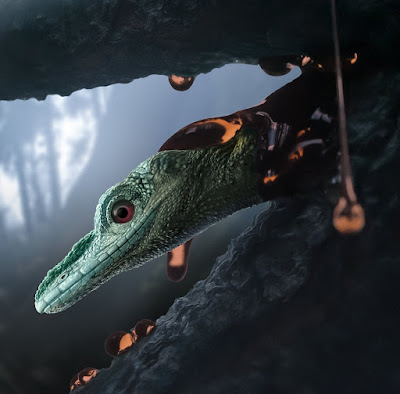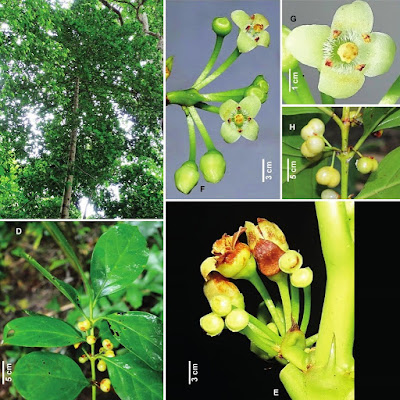[Most Recent Entries] [Calendar View]
Tuesday, June 15th, 2021
| Time | Event | ||||
| 3:10a | [Paleontology • 2021] Oculudentavis naga • Unusual Morphology in the mid-Cretaceous Lizard Oculudentavis (Reptilia: Squamata)
Highlights: • A new species of the reptile in amber, Oculudentavis, is described • Oculudentavis is a bizarre lizard, not a bird • The bird-like appearance of Oculudentavis is due to convergence in skull proportions Summary Oculudentavis khaungraae was described based on a tiny skull trapped in amber. The slender tapering rostrum with retracted narial openings, large eyes, and short vaulted braincase led to its identification as the smallest avian dinosaur on record, comparable to the smallest living hummingbirds. Despite its bird-like appearance, Oculudentavis showed several features inconsistent with its original phylogenetic placement. Here, we describe a more complete specimen that demonstrates Oculudentavis is actually a bizarre lizard of uncertain position. The new specimen is described as a new species within the genus Oculudentavis. The new interpretation and phylogenetic placement highlight a rare case of convergent evolution in skull proportions but apparently not in morphological characters. Our results re-affirm the importance of Myanmar amber in yielding unusual taxa from a forest ecosystem rarely represented in the fossil record. Keywords: burmite, dinosaur, lizard, HRCT, synchrotron, Myanmar, comparative anatomy, phylogenetic analyses, osteology, Cretaceous Oculudentavis naga new species Holotype: Peretti Museum Foundation, GRS-Ref-28627, a skull and anterior postcranial skeleton (Figures 1, 2A–2J, 3A, 3C, and S1). Three-dimensional model of new specimen available at https://tinyurl.com/Oculudentavis-L-1042 Type locality: The holotype specimen of Oculudentavis naga (GRS-Ref-28627) and the holotype of O. khaungraae (HPG-15-3) were recovered from the same mine (Aung Bar mine, 26° 09′ N, 96° 34′ E). Diagnosis: The holotype of O. naga (skull length = 14.2 mm) is somewhat smaller than that of O. khaungraae (skull length = 17.3 mm). Oculudentavis naga differs from O. khaungraae in having a jugal process of the maxilla that reaches caudally to less than 25% of orbit length; in having a long squamosal process of the postorbital; in having a relatively smaller braincase, with short, distally expanded basipterygoid processes (versus longer, unexpanded processes); and in having anterior palatal rami of pterygoids parallel, diverging posteriorly just behind the fossa columellae, interpterygoid vacuity nearly rectangular (versus divergent pterygoids, heart-shaped vacuity), rostral part of premaxilla shorter and proportionally wider than that of O. khaungraae, and less conspicuous platform on the dorsolabial surface of the posterior third of the dentary. Etymology: Combination of Oculudentavis (oculus = eye, dentes = teeth, and avis = bird) and Naga, the name of one of the many ethnic tribes living in the Burmese amber mines area. The Naga are mentioned in historical chronicles for their prominent role in amber trading. Divided into many sub-groups scattered across the hills and jungle of India (in Nagaland and other states) and in the Tiger valley region of Burma (where amber deposits are found), the Naga tribes are also reputed for their rich and fascinating culture.
Arnau Bolet, Edward L. Stanley, Juan D. Daza, J. Salvador Arias, Andrej Čerňanský, Marta Vidal-García, Aaron M. Bauer, Joseph J. Bevitt, Adolf Peretti and Susan E. Evans. 2021. Unusual Morphology in the mid-Cretaceous Lizard Oculudentavis. Current Biology. In Press. DOI: 10.1016/j.cub.2021.05.040 | ||||
| 7:54a | [Botany • 2020] Pyrostria laljii (Rubiaceae: Vanguerieae) • A New Species and First Record of Pyrostria from the Andaman and Nicobar Islands, India
Abstract Pyrostria laljii M.C. Naik, Arriola & M. Bheemalingappa (Rubiaceae) from the Andaman and Nicobar Islands, India is described and illustrated. It closely resembles P. cochinchinensis and P. subsessilifolia by having subsessile inflorescences and a very short peduncle. However, the presence of a 1 cm long petiole, a shorter glabrous pedicel and an 8–12-flowered umbellate inflorescence sets P. laljii apart from P. cochinchinensis and P. subsessilifolia. Pyrostria laljii represents the first record of the genus from the Andaman and Nicobar Islands. Mudavath Chennakesavulu Naik, Axel H. Arriola and Madiga Bheemalingappa. 2020. Pyrostria laljii, A New Species and First Record of Pyrostria (Vanguerieae, Rubiaceae) from the Andaman and Nicobar Islands, India. Annales Botanici Fennici. 57(4-6); 335-340. DOI: 10.5735/085.057.0416 |
| << Previous Day |
2021/06/15 [Calendar] |
Next Day >> |













